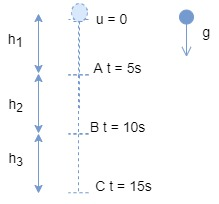Question
Question: A stone falls freely under gravity. It covers distance \( {{h}_{1}} \) \( {{h}_{2}} \) and \( {{h}_{...
A stone falls freely under gravity. It covers distance h1 h2 and h3 in the first 5 seconds, the next 5 seconds and the next 5 seconds respectively. The relation between h1 , h2 and h3 is:
(A) h1=2h2=3h3
(B) h1=3h2=5h3
(C) h2=3h1 and h3=3h2
(D) h1=h2=h3
Solution
We can use position time relation which is given by
S=ut+21at2
Here, S is distance travelled in time t,
u is the initial velocity,
a is the acceleration and t is time taken.
In case of free fall, if downward direction is taken positive and object is released from rest, then
u=0, a=g=10m/s2, S=h
In case of free fall, if downward direction is taken negative and object is released from set, then
u=0, a=−g=−10m/s2, S=−h .
Complete step by step solution
We have, given
Stone is falling freely under gravity.
It means, if we will take downward as negative
Then, a=−g
S=−h1
Case I: Where h1 is the distance covered in first seconds,
Here, stone is falling freely hence take initial velocity as zero.
u=0 , t=5s is given
Then use distance/position-time relation
S=ut+21at2
Here, a=−g , means acceleration due to gravity.
Put all the above values:

h1=225g ; −h1=0(5)+21(−g)(5)2
−h1=−21×g(25)
h1=225g ----------(2)
Now in Case II:
Distance travelled by stone in next 5 seconds,
Now total distance covered will be, S=−(h1+h2) [negative sign shows just direction of measurement]
And total time taken, t=5+5=10s
Put the above values in eq, (1)
−(h1+h2)=0(10)+21(−g)(10)2
(h1+h2)=21g(100)=2100g ---------(3)
Case III:
Distance travelled by stone in next 5 seconds,
Total distance covered S=−(h1+h2+h3)
Total time taken t=5+5+5=15s
Put the values in eq. (1)
−(h1+h2+h3)=−21g(15)2
(h1+h2+h3)=2225g ------- (4)
Solve eq. (2) and (3)
(h1+h2)−h1=2100g−225g
h2=275g -------- (5)
Solve eq. (3) and (4),
(h1+h2+h3)−(h1+h2)=2225g−2100g
h3=2125g --------- (6)
Write eq. (5) and (6) in terms of
h2=225×3g→h2=3h1 ---------- (7)
h3=225×5g→h3=5h1 ----------- (8)
From eq. (7) and (8),
h1=3h2=5h3 This is required result.
Therefore option (B) is the correct answer.
Note
We can also, use direct formula, Distance travelled in the second by,
Dn=u+2a(2n−1)
Here, n is nth second, above question n is given as 5s.
Using the above formula we will get the same answer.
